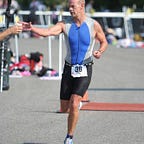Improve Your Bicycle Ride Performance and Enjoyment
As the weather gets warmer, I am (as with every spring) noticing a lot of bicycle riders coming out of hibernation: spinning through parks and along bike trails, commuting to work, doing errands on a bike. Sprinkled in to this set are the “serious” bikers pushing themselves physically to improve their speed and endurance. Some are competitive bike racers on road, cyclocross, or mountain bikes. Some are triathletes training for the bike leg of the swim/bike/run events. Some are pushing themselves for bragging rights in their local weekend biker club. Most of the serious bikers are on a relatively expensive bike to maximize their performance. Unfortunately some of these bikers have configured their expensive bike and equipment for a non-optimal ride, reducing the performance gains they hope to achieve and/or generating back/knee/shoulder/coccyx pain.
This article discusses some common, and frequently overlooked, quick tips to gain bicycle enjoyment and performance. Whether you’re looking into a Specialized Venge with Enve carbon disc wheels (~$11000) or already have a bike you like, this article suggests some common sense tips, but clearly overlooked by some bikers, to consider.
What qualifies me for giving this advice? I’m not a professional but I have ridden over twenty 100+ mile bike rides and, over time, improved my performance and enjoyment of training for and racing in tri’s. During my first of three ironman events, I was miserable at mile 80 (of 112) on the bike. I had shoulder pain, butt pain, and a hot-spot on my left foot. I suffered during the remaining 32 miles of the bike. From there I gradually embraced the following tips.
Bike Fit
Get a professional bike fitting session to understand the best geometry for you and how to maximize your power. The fitting session is generally on a maximally adjustable stationary bicycle with a power meter (for example the Retul System.) The fitter will adjust the saddle height and position, handlebar height and position. If you have a saddle you like, the fitter will use that. You will need to bring your bike shoes and apparel for the fitting session.
Another option, if you have a bicycle on which you want to tune your configuration, can be mounted into a bike trainer setup with a power meter.
What will come out of the fitting session is a detailed report of the optimal:
- saddle height, angle, setback
- handlebar reach, stack, drop, width
- frame stack
- a bunch of ancillary adjustments
The two most useful geometry measurements are the frame stack and handlebar stack/reach, described in this article.
Based upon the fitter’s report you can look at new bikes that fit your geometry. DON’T buy a bike with a geometry that is far removed from your optimal fit, even if it is that Venge you had your eyes on.
If you have already have a bike, adjust it as close to your ideal geometry as possible. In my experience, the saddle is almost always either too low or too high and the stem is generally too long. Adjusting these to match your optimal
power makes a HUGE improvement.
Shoes and Inserts
Unless you have very high-end bike shoes (for example, professionally hot-molded to your feet), replace the inserts with third-party carbon inserts (also called insoles.) These can go from $35/pair to $200/pair. The inserts add stability to the bike shoes so that they bend less, resulting in better power transfer from your legs to the pedals and thus more power propelling the bike forward.
Also, the carbon inserts act almost like a plank that distributes the pedal over the entire foot to reduce hotspots.
Saddle
This is the most individual part of the bike and, as a result, the source of coccyx and perineum pain. And it seems like everyone has a different opinion about the best saddle, which may or may not work for you. Try as many saddles as you can to determine your preference. If your current one is uncomfortable, or gives you problems on long rides you need to change it.
Some bike shops will rent out saddles for you to try, or ask around to try your friends saddles. I think I have over a dozen saddles (starting with a Fisiks rail-thin saddle recommended by a pro but I was miserable on), eventually finding the best for my road bike and another for my gravel bike that are comfortable.
Body Weight
This goes without saying but I have to say it anyway. You can spend thousands on a super-lightweight frame (the Cervelo S5 frameset is under 2 lbs!) and get great performance. But dropping 5lbs of body weight will be even better for your health and wallet AND performance.
Summary
Spend $100-$200 on a bike fit, $35 on carbon inserts and $150 on a good saddle that YOU like, and cut your food bill a little. I guarantee you’ll enjoy
riding more. And next time your buddies try to race up that final hill, you’ll
be right there, or ahead of them.
